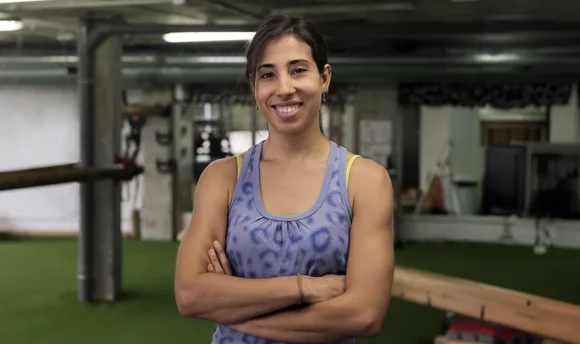How to Start Working Out: A Beginner's Guide to Building a Workout Routine That Sticks
Attaining your fitness goals means creating an exercise program you can sustain for the long haul. But how can you do it?

Adults need a minimum of 150 minutes of moderate-intensity exercise weekly, paired with strength training two days a week. Regular exercise of any kind has health and wellness benefits, like better brain health, weight control, and lower chronic disease risk.
All humans need to exercise, but starting an exercise program is sometimes easier said than done. Beginning your journey with the right mindset and building a unique workout schedule can make all the difference to your engagement, motivation, and success.
Learn how to break into the world of exercise with a routine you can commit to.
How to Start Working Out: A Step-by-Step Guide
It can be challenging to maintain a regular exercise routine. You might be new to the concept or have taken some time out due to illness, injury, or life events. But whether it’s your first time ever or your big return, building a workout routine can be taxing.
At this time, it’s important that you execute an entry-level fitness program that works for you. You can do this by following simple steps to set yourself up for success, from thinking realistically to tweaking your environment to retrain your brain.
Follow 9 steps, and you’ll soon be on the road to better health:
- Check your health
- Find your ‘why’
- Set realistic goals
- Choose an exercise you like
- Create a workout plan that suits you
- Just show up and expect imperfection
- Create a motivating environment
- Find a workout buddy
- Track your progress
#1 Check your health
To be safe, begin your fitness journey with a trip to your doctor. A checkup is particularly important if you’re new to exercise, have been inactive for a while, or you’re returning after recovery.
A physical medical examination will determine if you’re fit and ready to exercise regularly. For example, it can highlight any health problems that might influence the type and intensity of the training you want to begin. Furthermore, it can help tailor a plan to match your needs.
#2 Find your “why?”
Exercise is a personal endeavor, and behind it, there is usually a reason to start exercising. Identifying your reasons can fuel your motivation, as it helps solidify your goals, be it to lose weight, tone up, increase flexibility, or care for your cardiovascular health.
The great thing about exercise is it has countless health benefits. Perhaps weight loss drives you, but you’ll strengthen your bones, muscles, heart, lungs, and other organs at the same time.
#3 Set realistic goals
You might have big goals when starting a new workout routine, but you can’t expect changes overnight. Instead of setting unrealistic goals and facing disappointment, set realistic ones. That way, you can be sure to achieve success.
Using the SMART criteria can help you define realistic goals. SMART is an acronym that stands for specific, measurable, achievable, realistic, and timed. Deciding to engage in 30 minutes of aerobic activity, three days a week, for the next four weeks, is an example of a SMART goal because it covers all benchmarks.
Some goals take longer than others. There’s a difference between running a 5K and running a marathon, just as there’s a difference between losing 2 pounds and 20.
Whatever your ambition, it can help to break down the end goal into smaller, more specific goals. In the case of running, you can begin by mastering three short runs per week before increasing the distance. Eventually, you can build toward running your first 5K.
It’s a great motivational boost when you continuously smash your goals, no matter how small. It highlights that you can indeed succeed, encouraging you to keep going.
#4 Choose an exercise you like
Like anything, you’re more likely to stick to exercise if you enjoy it. Research into exercise and enjoyment shows that higher levels of joy can influence exercise habits, the intention to continue exercising, and exercise frequency.
In other words, choose an activity you like because it will help you stay motivated and increase your commitment to exercise. It doesn’t have to be one activity, either. You can split your weekly minutes between resistance training at the gym, a dance class, and a brisk walk.
Other examples of exercise include:
- Jogging
- Running
- Biking
- Boxing
- Swimming
#5 Create a workout plan that suits you
For a workout plan to work, it needs to fit into your lifestyle, preferably with ease. It is one of the most critical steps to making exercise a habit because if it doesn’t suit you, it simply won’t work. So, how do you choose from the many workout plans available?
Start with the basics. Ask yourself: Are you a morning person? Do you have more energy in the evening? Do you have free time during your lunch hour?
Figuring out the best time to work out will help secure your plan in place. You can opt for morning workouts, evening workouts, or a combination of timings to fit around work and other commitments. Plan your activities in advance and lock them in on your calendar.
You need at least 150 minutes per week – fit them in wisely. Remember, you don’t need to squeeze in all your exercise at once. You can include short bursts of activity throughout the day, such as cycling to work or walking to fetch your morning coffee.
A certified personal trainer or coach can assist you in preparing the perfect schedule.
#6 Just show up and expect imperfection
Exercise is a learning curve. It takes consistency, time, and practice to perfect your activities and hone your form, and even then, there is always room for improvement.
So, remove the idea of perfection from your mind and, instead, expect imperfection and carry on. Things don’t always go according to plan, as many factors can result in you skipping a workout, such as illness or other commitments, but that doesn’t mean you have to give up.
Show up to your sessions, do your best, and change things if necessary. Create a plan B, even if it means cutting down your four-day workout week to two days. You can always rearrange and change your exercise program – what matters is that you don’t quit.
#7 Create a motivating environment
Creating the right environment can help you remain consistent with a workout regimen. You can start by eliminating any stress that might interrupt your daily routine, such as packing your gym bag the night before or buying new workout clothes and placing them by the bed.
You can get creative with your space at home or in the office. Visuals like motivational posters or creating a calendar that you can check off each time you work out can be a good reminder.
It’s also worth considering the motives that drive you. Intrinsic motivation is the motivation that comes from the inner desire to attain a goal, providing internal satisfaction. In contrast, extrinsic motivation is driven by the desire to receive a reward or praise for your efforts.
If you need persuasion to work out, consider planning a treat for yourself after completing your schedule, such as a shopping trip or cooking your favorite dinner.
#8 Find a workout buddy
Instead of doing it alone, grab a buddy to join you in your fitness ventures. You can support, encourage, and motivate each other to continue.
You’re more likely to show up if your presence affects somebody else. For instance, your buddy might be counting on you for a ride or to partner up with them in class. Whatever the circumstances, buddying up can keep you accountable.
Another positive is that having a friend by your side can make you feel more comfortable trying new things, such as attending a spin class or swimming on the weekend. It can remove any self-consciousness that you might have about exercising solo.
Research suggests that participation in collective training events encourages the physical benefits of physical activity but also the mental benefits of connecting and integrating with others. Subsequently, these positives may increase enjoyment, energy, and performance.
#9 Track your progress
Tracking your progress helps you stay on target with your goals and fuels your motivation. You can see clearly how far you’ve come and how much closer you’re getting to the finish line. It also ensures your training plan is working and getting you where you want to be.
Technology advancements make self-tracking easy, as you can access valuable data using your smartphone or wearable tracking device. People can now discover more about themselves, from daily steps and calories burned to eating and sleeping habits.
Apps are ideal for progress tracking. Many are even activity-specific, providing a more personalized approach to your new exercise plan. For example, the best running apps can track your running routes, speed, distance, calorie intake, water intake, and more.
Try a walking app with a fitness tracker to refine your new walking training plan. The Walking.Diet app offers the ultimate program for newcomers to kickstart their health journey.
5 Beginner Tips for Working Out
Now you know how to begin an exercise routine, it’s vital to get the most out of it and safely progress toward your goals. This means taking care of your body to ensure you keep feeling good, from eating nutritious foods to being mindful of your capability.
Incorporate the following tips into your fitness routine to secure the many health benefits of exercise.
#1 Stay hydrated
You need to hydrate your body with fluids to replenish those you lose through sweat. Drinking water keeps you in prime condition for exercise as it regulates your body temperature, carries nutrients to improve energy levels, and fuels the muscles, putting you in a stronger position to conquer your workouts.
Dehydration can tire you out as it impairs your system’s ability to regulate heat, causing an increase in body temperature and heart rate. These factors degrade exercise performance, and dehydration at severe levels can trigger hydration-related illnesses, such as hyponatremia, when sodium levels in the blood drop.
You can maintain hydration levels by drinking enough water before, during, and after exercise.
#2 Fuel your body properly
Supplying your body with the nutrients it needs ensures you can do your best work, as you’ll have the energy to attain maximum performance. You can get enough nutrients from a balanced diet consisting of carbs, healthy fats, fiber, and protein.
Carbs are your friend unless you’re following a low-carb diet like keto. They are the only macronutrient the body can break down quickly enough to give you energy during high-intensity exercise. High-quality carbs come from whole foods like brown rice, oats, and potatoes.
Sometimes, supplements are beneficial if you struggle to get your vitamins and minerals from diet alone. Runners, for example, can use running supplements to replenish electrolytes lost through sweat, including sodium and potassium.
#3 Don’t forget about warm-up and cool-down
Beginners must learn the importance of warming up before a workout and cooling down afterward. Warm-ups lessen injury risk and prevent muscle soreness, while cool-down exercises promote post-exercise recovery, including faster respiratory system recovery.
A warm-up features activities that raise your heart rate and get your blood flowing, like a brisk walk, jogging on the spot, or walking lunges. A slow walk and stretching while your muscles are still warm helps you wind down and return to your usual state.
Many fitness apps include specific exercises to ensure you prepare and recover properly.
#4 Pick a different workout if you get bored
If you’re new to exercise, it might take some time to discover the physical activity that satisfies you after each session. Naturally, you might enjoy something one week and not the next. The important thing is to switch tactics when boredom creeps in.
Exercise engages not only your body but your brain too. Follow a training plan that mixes things up and stimulates you mentally. For example, high-intensity interval training keeps things interesting as it alternates between short bursts of intense movements and low-intensity recovery periods.
Another way to counter boredom is to partake in group exercise. Working out alone can get lonely, but joining a collective enables you to connect with others and restore your motivation.
#5 Don’t go overboard
You need to ask yourself how much exercise you will do each week.
Your chosen physical activity might excite you, but you mustn’t do too much too soon. Overexerting yourself can quickly lead to problems like muscle soreness, tendon injuries, and fatigue that disrupt your journey.
Rest and recovery are requisites of a good fitness program, and this is especially true at the beginning when your body is slowly adapting to working out. Even athletes require post-exercise recovery to maximize performance.
Always listen to your body and schedule a rest day at least 2–3 times a week. More doesn’t always mean better. Instead of pushing yourself to work out 7 days a week, start with just two workouts and give them your all. Working out twice a week is enough to benefit if you’re otherwise physically active, for example, walking or cycling to and from work.
1-Week Sample Beginner Exercise Program
As an exercise newbie, it’s best not to overdo it. Start with short workouts less than 30 minutes long and see how you find them. Evidence demonstrates that short activities under 10 minutes can also be effective.
You can then assess your fitness level and decide if you want something more challenging.
Below is a sample plan for a beginner’s exercise program. Feel free to adjust it accordingly to match your needs.
| Monday | 10 minutes cardio, 20 minutes strength training |
| Tuesday | Rest day |
| Wednesday | 30-minute brisk walk or light jog |
| Thursday | Rest day |
| Friday | 10 minutes cardio, 20 minutes strength training |
| Saturday | Rest day |
| Sunday | 30–40-minute long walk |
FAQs
When starting an exercise regimen for the first time, or the first time in a long time, the trick is to go slow and steady. Ease yourself in with low-impact activities and schedule a few days to rest in between. As your body adjusts, you’ll soon notice a difference in your fitness level.
20–30-minute sessions are ideal for beginners, but you should remain mindful of your limits and avoid pushing yourself too hard. As your muscles adapt and your cardiovascular system improves, you can gradually increase your training time to align with your fitness level.
Spending an hour in the gym per session is enough to improve your fitness, as it facilitates time to warm up, complete aerobic exercise or weight training, and cool down. However, an hour in the gym per week does not meet the minimum 150-minute recommendation.
Results vary from person to person, but you can typically expect to see changes within a month or two of working out 5 days a week. It gives you ample time to perform various activities, including cardio and lifting weights, enabling you to target all muscle groups.
A Word From a Personal Coach
Everybody should aim to move their bodies for at least 150 minutes a week. It sounds like a lot, but you can break it into smaller, more attainable chunks. Just half an hour of exercise daily, 5 times per week, is enough to hit your target.
One of the best ways to stick with a new routine is to have fun with it. Find an activity you enjoy, and your sessions will feel good rather than a drag. You might prefer a low-intensity activity like walking to ease yourself in before attempting higher-intensity workouts like running.
A trip to your healthcare provider will ensure your workout plans are appropriate for your health. Their professional recommendations can help to form a well-balanced regimen.
Conclusion
Starting to work out could be the best decision you ever make. Exercise improves your health in so many ways, which means you’ll look good and feel good too. It can be hard going at first, but it will get easier once you get to grips with a new routine.
Be sure to start slow and explore a range of exercises to find a few favorites you can switch between. Doing so will keep your training times fun and keep boredom at bay.

















































 Select your language:
Select your language: 








